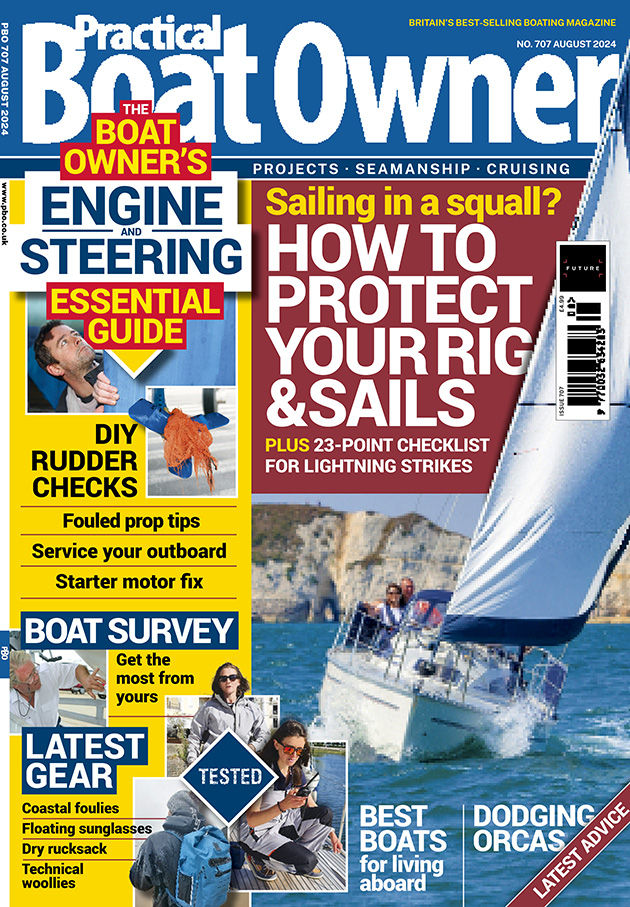Ben Russell gets busy constructing his own custom boat shed
Having recently finished building Athena, my 18ft plywood motorboat she was sitting on my driveway on her trailer, open to the elements, writes Ben Russell.
In only a short space of time, she’d started to look grubby, so I began to think about some sort of shelter to keep the worst of the weather off her and to make maintenance easier.
I looked online at fabric garages and tents but they all needed some sort of modification to get my boat in.
I’ve always been a keen DIYer so I sketched out what the ideal protection would look like.
I wanted an open shelter, and to get my boat under cover with enough room to walk down the side.

Posts and wallplates in place, with the ridge beam temporarily supported. The rafters are ready to be fitted. Credit: Ben Russell
This meant I’d need an internal width of 3.2m. I opted for a length of 7m to get the boat, engine and most of the trailer underneath.
A height of 3.5m at the apex, and a roof pitch of 25° would be adequate to get the boat under cover.
To build the boat port, I used 150mm square posts and concreted them into the ground 1m deep at 2m centres.
This would give me a small overhang at the front, which was necessary to make sure I could reverse the boat in.
Using an optical level to mark, and subsequently cut the tops of the posts, ensured the wallplate would be level.

Rafters complete, and two out of three purlins on each side. One more was fitted, just below the apex. Credit: Ben Russell
I cut a series of 50mm deep cuts across the outside of the posts at the top, with the last cut being 150mm from the top.
This could be chiselled out and the wallplate could then sit on this, rather than be hanging by the bolts.
End grain preservative was applied to the cut edges. I used 150mm x 50mm timber for the wallplate which was fixed to each post with two M12 bolts.
Lengths of timber aren’t available at 7m long so I cut a 400mm half-lap joint and glued and bolted the two halves together.
The ridge beam is 150mm x 50mm timber, again with a glued and bolted half-lap joint. I made some temporary supports to hold up the ridge beam while I fixed the rafters.

The completed boat port. Credit: Ben Russell
The rafters themselves were 100x50mm timber spaced at 600mm centres.
I used an online tool to give me dimensions for a rafter and made one as a rough template.
I dry fitted it and tweaked it to give a good fit, and then used this one as a template for the rest.
The rafters were nailed/screwed to the ridge and wallplate, in opposing pairs as I worked along the ridge.
For the roof covering, I decided to use box profile steel sheets – the 0.7mm plastisol-coated sheets have a good service life.

Athena under cover – a tarpaulin tied to the side posts keeps driving rain out. Credit: Ben Russell
These come in sheets of lengths to suit that cover 1m wide so I left the last pair of rafters off as I could put these where the final edge of the sheet lay, and then trimmed the ridge beam and wallplates to suit.
Finally, I added some timber soffits and some guttering to collect rainwater into a water butt. I put some concrete pads where the trailer wheels sit, though I may put a full concrete slab later.
As well as collar ties on the rafters near the apex, I have ordered some wire tie-straps using 6mm galvanised wire which fit near the bottom of the rafters and are removable so that I can get the boat out.
Editor’s note: In some circumstances, a car- or boat port may be allowed under permitted development without the need to gain planning permission – but do seek advice from your local planning authority before commencing a build.
Continues below…
How I built my own 18ft motorboat
Having already built a dinghy and a dayboat, Ben Russell decided to design and construct an 18ft Selway Fisher Clyde…
Motorboat handling: techniques for rough weather
Gilbert Park undertakes some training for riding out heavy seas and wind in his Mitchell 28 – but first has…
Why we swapped sail for power: 10 motorboaters explain their big switch
Many moons ago I had a premonition that Hunter Boats ought to build a classy little motorboat for customers who…
5 top causes of boat engine failure – and how to avoid them
Jake Kavanagh talks to Sea Start marine engineer Nick Eales about how to avoid the five major causes of an…
Enjoy reading How to build a custom boat port?

A subscription to Practical Boat Owner magazine costs around 40% less than the cover price.
Print and digital editions are available through Magazines Direct – where you can also find the latest deals.
PBO is packed with information to help you get the most from boat ownership – whether sail or power.
-
-
-
- Take your DIY skills to the next level with trusted advice on boat maintenance and repairs
- Impartial in-depth gear reviews
- Practical cruising tips for making the most of your time afloat
-
-
Follow us on Facebook, Instagram, TikTok and Twitter








